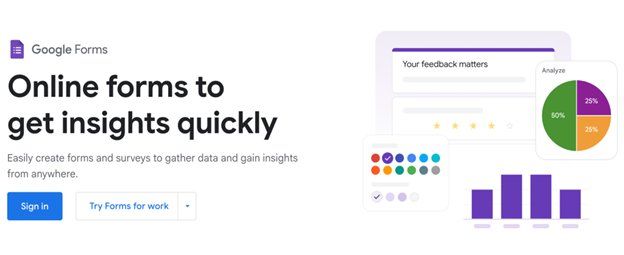Why you can trust TechRadar
We spend hours testing every product or service we review, so you can be sure you’re buying the best. Find out more about how we test.
Google Forms is an online form builder with robust functionalities, both on the free and paid tiers. It simplifies the process of creating and managing online forms to gather data from various audiences. It doesn’t have the most advanced data collection features, but it works well for collecting and analyzing simple data.
I reviewed Google Forms extensively so that you don’t have to go through the same stress. My review focused on essential factors, including its features, pricing, ease of use, and customer service. Read on to learn about Google Forms’ unique strengths, weaknesses, features, and how it fares against rival online form builders.
(Image credit: Google)
Google Forms: Plans and pricing
Google Forms is a freemium tool. Anyone with a Google account can access the free version and enjoy most features. The free version lets you create surveys to gather and analyze data. There’s no limit on the number of responses you can collect, as long as it fits within your allocated storage space.
Free users have 15 GB of storage for data collected on Forms and other Google tools. They’re also limited to self-service and community support. If you need more storage space, direct support, enhanced security, and collaborative features, a Google Workspace subscription unlocks these benefits.
Google Workspace is designed for businesses with employees who need access to Google’s software suite, which includes Forms. It unlocks premium features on Google Forms and many other Google tools, such as Docs (document editing), Sheets (spreadsheets), and Meet (videoconferencing).
Google Workspace has three pricing plans: Starter, Standard, and Plus. The Starter plan costs $7 per user per month and unlocks 30 GB of storage for each account. It also unlocks access to Gemini, Google’s artificial intelligence (AI) assistant, which can help you create online forms.
The Standard plan costs $14 per user per month. It provides 2 TB of storage per account, ample enough to store vast volumes of data collected via forms. It also includes access to Google Gemini and direct support from Google’s team if needed.
The Plus plan costs $22 per user per month and increases storage to a sizable 5 TB per account. It unlocks enhanced security features for organizations where data security is paramount. Google Gemini and direct support, which are available on other plans, are also included.
Google offers an Enterprise Plus plan with no regular pricing. This plan is designed for large companies, typically with a minimum of a few hundred employees, that can negotiate a custom plan with Google’s sales team.
The core features of Google Forms remain the same in both the free and paid versions. What differentiates the paid plans is access to Google Gemini, higher storage space, enhanced security, and access to advanced features on other Google tools.
Google Forms is designed as a simple tool for individuals and enterprises to gather and analyze data. It doesn’t have the most sophisticated features you’ll find on form collection tools designed specifically for businesses, but it works well for everyday forms.
(Image credit: Google)
Google Forms: Features
Google Forms offers a decent set of functionalities that enable you to create and manage online forms. It lacks some sophisticated analytics, customization, and integration features, but it meets most basic form creation needs.
To start, Google Forms has a library of pre-loaded form templates. Examples include templates for party invites, event registrations, online orders, and RSVPs. You can use these templates as the foundation for your forms, instead of going through the hassles of creating them from scratch.
Whether you select an existing template or create a form from scratch, Google Forms makes the creation process noticeably easy. You can input as many questions as you like in a numbered format. Existing questions can be rearranged by dragging and dropping them in the desired positions.
Each question on a form can have various response formats, including a short text, paragraph, multiple choice, checkboxes, dropdown list, rating, date, time, and even a file upload. Any uploaded files will count towards your allocated storage space, so carefully consider this if you’re creating forms for a large number of recipients.
You can insert images to add context to a question. A question can be compulsory or optional, depending on your preferences for collecting data. The short text format lets respondents answer a question in a single line, and the paragraph format allows respondents to type their answers in multiple lines.
You may choose to make your questionnaire a quiz, with point values assigned to each answer and automatic feedback once the respondent completes the questions. You can choose to collect email addresses during your response, and respondents can receive an email copy of their answers after completing the form.
As a respondent completes a form, you can choose to display a progress bar highlighting how far they’ve gone and how many answers are left. You can also choose to shuffle the question order for each respondent. Likewise, you can display a custom message after a respondent clicks the submit button, e.g., “Thank you for your response!” These features may sound trivial, but they go a long way in creating an interactive form that people are encouraged to complete.
I liked that Google Forms allows respondents to edit their responses after submitting a form. This feature is helpful, given the tendency for people to make mistakes when filling out forms. For instance, if I create a form asking people for their opinion about a product, it’ll be helpful to allow them to edit their responses after interacting with the product repeatedly. However, the response editing feature isn’t enabled by default. You have to toggle it on manually.
(Image credit: Google)
Notably, respondents don’t have to complete a form in one go. If a respondent has a Google account, which includes most online users anyway, and is signed in, their responses to each question are saved as a draft for 30 days. They can close the form and return within 30 days to the same responses, then complete the rest and finally press the submit button.
With your form created, you can share the link via email, social media, or embed the form on your website. All responses will be collated and displayed in a single dashboard, making them easy to analyze. You can export the responses to Google Sheets for further analysis.
Google Sheets comes in handy if the responses are numerical, as you can use formulas to analyze them. For example, I created a mock quiz and got mock responses from some friends and colleagues. Then, I used Google Sheets to grade the forms automatically. You can conduct real quizzes and grade them just like I did, saving considerable time, especially when dealing with many respondents.
On Google Sheets, you can also generate charts to visualize responses, from bar charts to pie charts, line charts, and scatter plots. I liked that the charts were very customizable, but that sounds more like something to discuss in a Google Sheets review than in Google Forms.
I mentioned earlier that Google Forms’ core features don’t differ much between the free and paid plans, but the latter unlocks valuable collaboration functionalities. Under a Google Workspace plan, multiple users can collaborate in real-time to create and edit forms.
For example, five employees can work on the same form, with each adding questions and configuring settings. Every employee can monitor each other’s changes on the form and message each other via Google Chat to clarify changes.
A standout feature on Google Forms is its support for conditional logic, i.e., showing or hiding questions based on a responder’s previous answer. For example, in a survey about which smartphone brands people use, selecting “iPhone” opens a new question of “Which iPhone do you use?” and selecting “Samsung” opens a new question of “Which Samsung smartphone do you use?”
However, Google’s conditional logic support is basic. It doesn’t allow the most complex workflows that are permitted in various business survey tools. Generally, Google Forms excels in basic form management but has limited dynamic features. It doesn’t have as many integrations and customizations as you’d find in survey apps like Qualtrics XM.
For example, Google Forms doesn’t let you directly capture signatures from respondents, detect a respondent’s geographic location, or generate PDFs from form data. Though it’s slightly customizable, all forms created on Google Forms retain a similar structure, which doesn’t bode well for businesses that always want to deliver a unique experience.
Google Forms integrations are mostly limited to other Google tools, but with few third-party integrations compared to rival survey apps. Another drawback is that while Google Forms lets you embed forms on a website, you can’t host the form directly on a custom domain.
From my perspective, Google Forms was created mainly as a free tool for individuals and businesses to manage everyday online forms. It works excellently for basic forms, with features that many rivals charge money for. However, if you need an online form app with extensive integrations, customizations, and features, you’re better off with an alternative.
Google Forms: Interface and in use
Google Forms scores an A+ in simplicity and ease of use. The interface is as simple as it gets, which I’ve observed as the norm with Google tools. From creating forms to viewing and analyzing responses, the Google Forms interface is easy to navigate. It helps that the app doesn’t have many complex features, so it isn’t hard to familiarize yourself with the interface.
You can easily add questions, rearrange them, and insert visual elements when creating forms. After creating a form, the Publish button is prominently displayed at the top-right corner, so you can click it and share the form with respondents. I liked that Google Forms has many keyboard shortcuts that make navigation more fun, although it took me some time to master them.
Google Forms is accessible only via the web interface. There are no dedicated desktop and mobile apps, unlike some rival tools.
Google Forms: Support
Google Forms users have access to reasonable support resources, depending on their tier. Free users can scour through the Help Center to resolve issues. The Google Forms section of the Help Center contains abundant user guides that will help you troubleshoot issues.
Free users can also check Google’s official support forum for answers to their questions. If the answer isn’t present, you can ask a new question and expect answers from other Google Forms users, but there’s no guarantee. Fortunately, Google Forms’ intuitive interface means you wouldn’t encounter many problems in the first place.
If you’re subscribed to Google Workspace, you can get direct help from Google’s support team via email, telephone, and live chat. Google has a 24/7 support team, but response times can vary depending on your location and the type of issue. Nonetheless, Google offers decent support with few complaints.
Google Forms: The competition
Google Forms has many rivals with unique strengths and weaknesses. As I’ve mentioned, Google Forms doesn’t have the most advanced features you’ll find in some rivals. SurveyMonkey is the main competitor I’d like to highlight and examine what sets it apart from Google Forms.
SurveyMonkey doesn’t have an interface as intuitive as that of Google Forms. However, it offers more sophisticated features, integration, and customizability. With SurveyMonkey, you can create more dynamic forms and customize them to fit your brand.
The built-in analytics features are more comprehensive on SurveyMonkey than on Google Forms. SurveyMonkey has many more third-party integrations, making it an ideal choice for businesses that want to conduct complex surveys.
The drawback is that SurveyMonkey isn’t as cost-effective as Google Workspace, considering the additional features you’ll get with the latter outside Google Forms. SurveyMonkey does have a free plan, but with minimal features compared to Google Forms’ free version.
Google Forms: Final verdict
Google Forms fulfills a valuable need for creating simple online surveys and collating responses. It’s the go-to tool I recommend for individuals or businesses seeking to conduct simple surveys.
However, if you need the most complex survey features and extensive customization, it’s not the best choice. Google Forms is perfect for small surveys but not large-scale ones.
We’ve featured the best survey tools.










